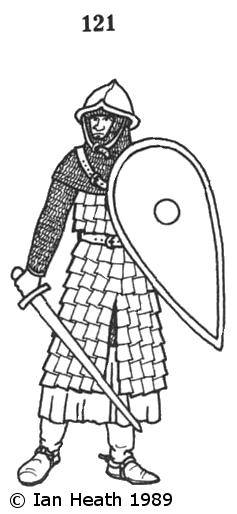|
|
HUNGARIAN HEAVY CAVALRYMAN, 12th CENTURY
An extract from Armies of Feudal Europe 1066-1300
by Ian Heath

121. HUNGARIAN HEAVY CAVALRYMAN, 12th CENTURY
Taken from a relief on the west door of Trogir Cathedral,
the equipment of this Croatian is probably characteristic of the traditional forms that prevailed in the Hungarian kingdom prior to the adoption or Western European panoply,
others probably resembling those of neighbouring Poland, South Russia and western Serbia.
His armour comprises a mail hood and a long-sleeved hauberk worn under a sleeveless corselet that may be lamellar,
though the irregular arrangement of its plates suggests that it consists instead of a leather foundation to which the plates or scales are secured by thongs or rivets,
overlapping outwards and downwards.
The helmet is a brimmed variety that was seemingly popular in the Balkans since it occurs in Bulgarian frescoes even as late as the 15th century.
Conical helmets with and without nasals were also in use, some being of spangenhelm construction.
A single, large feather was often fixed to the crown of the helmet in Hungary as an indication of rank, this being an old Magyar custom that persisted into the mediaeval period.
[Based on a carving on the tympanum of the west door of Laurentius Cathedral, Trogir, in Dalmatia, Croatia, by Master Radovan, 1240AD.]
Next: 122. HUNGARIAN KNIGHT, 13th CENTURY in Armies of Feudal Europe 1066-1300 by Ian Heath
|

